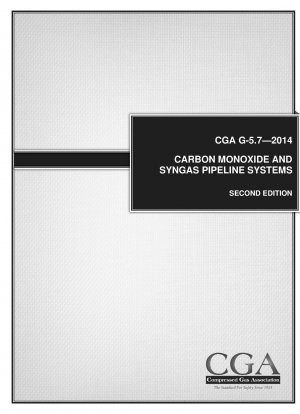CGA G-5.7-2014
CARBON MONOXIDE AND SYNGAS PIPELINE SYSTEMS
- Standard No.
- CGA G-5.7-2014
- Release Date
- 2014
- Published By
- Compressed Gas Association (U.S.)
- Scope
- The scope of this publication is for transmission and distribution piping systems for carbon monoxide and hydrogen and carbon monoxide mixtures (referred to as Syngas in the remainder of this publication). Typical arrangements for these pipeline systems are shown in Figure 1 of Appendix A. It is limited to gaseous products with a temperature range between -40 ℃ and 150 ℃ (-40 ℉ and 302 ℉), pressures from 0.1 MPa up to 15 MPa (14.5 psi up to 2250 psi), and the purity criteria defined in Appendix F.This publication does not apply to the following processes:- cylinder filling plants;- producing plants;- compressor units;- bulk facilities (liquid or high pressure gas) at the customer's site up to the point where gas enters the distribution systems; or- piping on specialized equipment and machines.These systems have many specialized needs and requirements. However, this publication may provide useful background information in other processes where carbon monoxide is present.With regard to the preceding, see Appendix H, References 6.1, 8.1, 8.2, 9.1, 9.2, and 12.1.The purpose of this publication is to further the understanding of those engaged in the safe design, operation, and maintenance of transmission and distribution systems. It is not intended to be a mandatory standard or code. It contains a summary of the current industrial practices. It is based upon the combined knowledge, experience, and practices of the major producers in Western Europe and North America.Some of the practices represent conservative compromises and not all situations are described. The designer is cautioned that this publication is not a complete design handbook and does not negate the need for competent engineering judgment and interpretation. The user should review any special problems or concerns with the carbon monoxide/Syngas supplier who should be able to provide advice and guidance.Although the technical information provided in this publication is not intended to be mandatory, the word "shall" is frequently used. Shall is used to indicate requirements strictly to be followed in order to conform to this publication and from which no deviation is permitted. Should is used to indicate that among several possibilities one is recommended as particularly suitable, without mentioning or excluding others, or that a certain course of action is preferred but not necessarily required.
